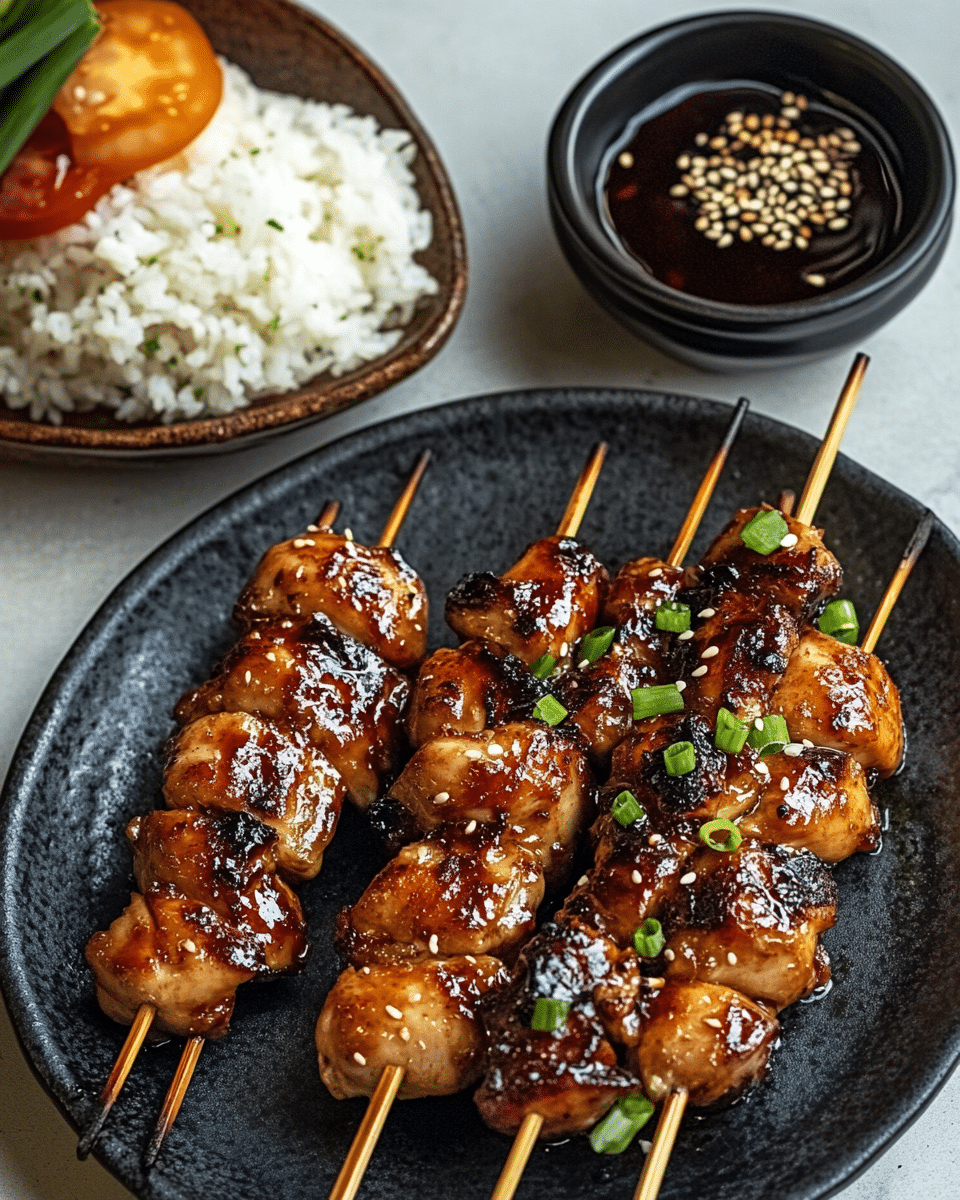Chicken Yakitori is a beloved Japanese street food that combines tender, juicy grilled chicken pieces with a delectably sweet and savory glaze. The skewered chicken is perfectly caramelized over high heat, creating an irresistible contrast between smoky char marks and a sticky, flavorful sauce. Garnished with fresh green onions and a sprinkle of sesame seeds, this dish delivers vibrant colors and textures on every bite.
What makes this recipe so special is its balance of simplicity and bold flavor. The marinade and glaze, made from classic ingredients like soy sauce, mirin, sake, and sugar, meld beautifully with the natural savoriness of the chicken. Whether you’re serving it as an appetizer, party snack, or part of a full Japanese meal, these skewers bring a genuine taste of Japan right to your table, easily achievable at home with a grill or grill pan.
Full Recipe:
Ingredients:
-
1 lb boneless, skinless chicken thighs, cut into bite-sized pieces
-
8 bamboo skewers, soaked in water for 30 minutes
-
1/4 cup soy sauce
-
1/4 cup mirin (sweet rice wine)
-
2 tablespoons sake
-
2 tablespoons sugar
-
2 garlic cloves, minced
-
1 teaspoon grated fresh ginger
-
2 green onions, thinly sliced (for garnish)
-
Sesame seeds (optional, for garnish)
Directions:
-
In a small saucepan, combine soy sauce, mirin, sake, sugar, garlic, and ginger. Bring to a boil over medium heat, stirring until the sugar dissolves. Lower the heat and simmer for 5-7 minutes until the sauce thickens slightly. Remove from heat and set aside.
-
Thread the chicken pieces evenly onto the soaked bamboo skewers.
-
Preheat a grill or grill pan over medium-high heat. Lightly oil the grates to prevent sticking.
-
Grill the chicken skewers for about 3-4 minutes on each side, brushing generously with the yakitori sauce during the last few minutes of cooking to build a glossy glaze. Chicken should be cooked through and nicely charred.
-
Remove from grill and brush with any remaining sauce. Garnish with sliced green onions and sesame seeds, if desired.
-
Serve hot as a delicious appetizer or part of a Japanese-inspired meal.
Prep Time: 15 minutes | Cooking Time: 15 minutes | Total Time: 30 minutes
Kcal: Approximately 280 kcal per serving | Servings: 4 servings
Discovering the Delight of Chicken Yakitori: A Japanese Culinary Classic
Chicken Yakitori is one of Japan’s most beloved street foods and a shining example of how simplicity and technique can create extraordinary flavor. At its core, Yakitori consists of bite-sized pieces of chicken threaded onto bamboo skewers, grilled over an open flame, and coated with a luscious glaze that’s equal parts sweet, salty, and savory. While it might appear straightforward, this dish embodies a rich culinary tradition, nuanced flavors, and a cooking method that has been refined over centuries.
The Origins and Cultural Significance
Yakitori traces its roots back to the Edo period in Japan (1603-1868), when grilled foods became popular as convenient and satisfying fare for people on the go. It gained widespread popularity in the post-war era, especially after World War II, as street vendors began selling inexpensive grilled skewers to the working class. The portability of skewers, combined with their affordability and bold flavor, made Yakitori an instant hit.
In modern Japan, Yakitori has transcended its humble street food origins and can be found in everything from casual izakayas (Japanese pubs) to upscale restaurants specializing in skewered delicacies. These eateries often serve an assortment of yakitori styles, featuring not just chicken but also other cuts like liver, skin, cartilage, and even vegetables. The communal atmosphere of eating yakitori in an izakaya fosters social interaction, with friends sharing skewers over drinks, making it a symbol of connection and conviviality.
Flavor Profile: The Magic of the Glaze
What truly sets Chicken Yakitori apart from other grilled chicken dishes is the signature sauce, known as tare. This glaze is traditionally made from soy sauce, mirin (a sweet rice wine), sake, and sugar, carefully simmered to create a thick, shiny, and deeply flavorful coating. The balance of salty umami from soy sauce and the natural sweetness of mirin and sugar makes the sauce addictive and perfect for glazing over smoky grilled chicken.
During grilling, the sauce caramelizes beautifully on the surface, giving each bite a delightful stickiness with layers of flavor that develop from the charring and the glaze’s glaze. The slight smokiness from the grill combined with the rich, tangy sauce provides a harmony of tastes that satisfies the palate.
The Art and Science of Grilling Yakitori
While Yakitori looks deceptively simple, achieving the perfect skewer requires attention to detail and technique. The chicken pieces need to be uniform in size to ensure even cooking, and the grill’s heat must be managed carefully to avoid drying out the meat or burning the glaze.
Traditionally, Yakitori is grilled over binchotan, a type of Japanese charcoal known for its steady heat and clean burn. This charcoal imparts a subtle smokiness that complements the chicken without overpowering the delicate glaze flavors. However, home cooks can replicate similar results using a charcoal grill or a grill pan over medium-high heat.
Basting the skewers repeatedly with the tare during grilling is key. This layering of sauce builds up a shiny, caramelized exterior while locking in moisture. Some chefs also finish the skewers with a final brush of sauce off the heat to add an extra glossy finish.
Versatility and Variations
Though the classic Chicken Yakitori uses thigh meat for its juiciness and tenderness, this style of grilling allows for many creative variations. Different parts of the chicken, such as breast, wings, skin, or even offal like liver and heart, can be skewered and grilled. Each cut offers a unique texture and flavor profile, showcasing the versatility of the yakitori technique.
In addition to the tare sauce, another popular style is shio (salt) yakitori, where the chicken is simply seasoned with sea salt and grilled to highlight the natural flavor of the meat without the sweet glaze. Some restaurants serve both versions to please different tastes.
Vegetables such as green onions (negi), bell peppers, shiitake mushrooms, and even tofu can be skewered and grilled alongside the chicken for a more varied and balanced yakitori experience.
Serving Suggestions and Pairings
Chicken Yakitori is often enjoyed with a chilled glass of sake, Japanese beer, or shochu. The interplay between the slightly sweet and savory flavors of the skewers and the crisp, refreshing drinks creates an ideal balance. In Japan, this combination is a staple in casual dining and social drinking culture.
For a complete meal, Yakitori pairs well with steamed rice, pickled vegetables, and a light miso soup. The simplicity of the skewers complements these sides without overwhelming the palate.
Bringing Yakitori Home: Tips for Success
Recreating authentic Yakitori at home can be a rewarding experience. Using quality chicken thighs ensures juicy, flavorful bites. Marinating the chicken briefly in the tare or a simplified version of the sauce can enhance depth of flavor, although many cooks apply the sauce primarily during grilling.
If using wooden skewers, soaking them beforehand prevents burning and helps maintain their integrity on the grill. For those without access to a charcoal grill, a stovetop grill pan or broiler can produce satisfying results.
The glaze can be made ahead and stored in the refrigerator, making weeknight grilling quick and convenient. Just remember to baste generously for that classic sticky finish.
Health Considerations
While Yakitori is a grilled chicken dish, it’s important to note the sugar content in the glaze can add to the overall calorie count. Using lean cuts like chicken breast or reducing the sugar in the tare can make it a lighter option. Grilling also allows excess fat to drip away from the meat, making Yakitori a healthier choice compared to fried chicken dishes.
Conclusion:
Chicken Yakitori is much more than grilled chicken on a stick it’s a cultural experience wrapped in simplicity, tradition, and irresistible flavor. The combination of tender chicken, smoky char, and a balanced sweet-savory glaze has earned its place as a cherished Japanese culinary icon. Whether you enjoy it from a bustling street vendor in Tokyo or make it at home for friends and family, Yakitori is a dish that brings people together, sparks conversation, and satisfies the soul.
Its ease of preparation and versatile nature make it accessible to cooks of all levels, while the depth of flavor rewards attention and care during cooking. By mastering Yakitori, you gain not only a delicious dish but also a glimpse into Japan’s rich food heritage and communal dining culture. For anyone looking to explore Japanese cuisine beyond sushi and ramen, Chicken Yakitori is the perfect place to start.






